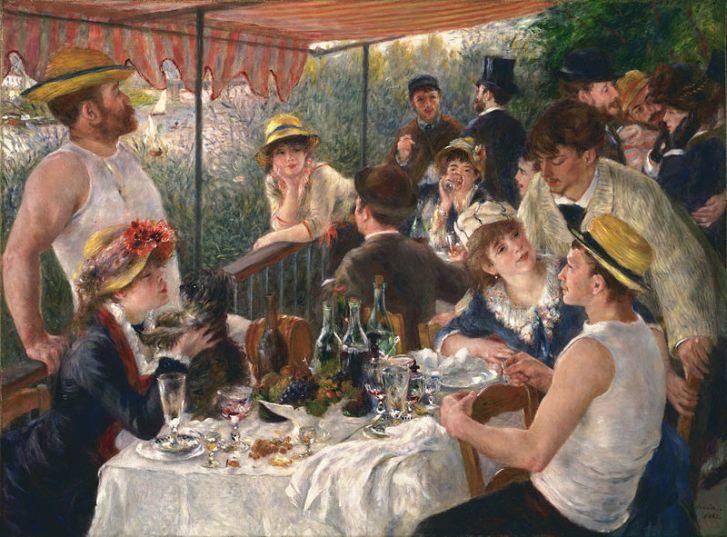
‘Luncheon of the Boating Party’ [1880 to 1881] by Pierre-Auguste Renoir, Oil on canvas, 51.26 in (h) x 69.13 in (w).
https://en.wikipedia.org/wiki/Pierre-Auguste_Renoir
For an interactive image ala ‘Luncheon of the Boating Party’ please click here and hover your mouse over the people in the painting: https://en.wikipedia.org/wiki/Template:Renoir-BoatingParty-ImageMap
Interlude. I will return to writing this article after eating some much needed food and drinking a lovely cup of tea. Sorry, Renoir’s painting has made me hungry and I simply cannot write another word after this one.
I wish my thoughts to flow satiated as I am. Renoir’s work is precise, pastel-soft at times, spontaneous like eating, romanticized, prettily arranged and sometimes pre-Renaissance and/or pre-Raphaelite in style.
Pierre-Auguste is capable of realist depictions wherever he felt the subject material became ameliorated. We see examples of this in his portraits of Claude Monet and Alfred Sisley, elevating their dignity and social standing. Quite likely Renoir ‘clung to them’ with strong regard.
At this latter well known saying I thought immediately of Michel de Nostredame [Nostradamus – https://en.wikipedia.org/wiki/Nostradamus] and his distinctive oddities.
‘If a meteorologist predicts troublesome weather, for thoust seeth through eyes that you do not see – do you then say that the meteorologist is a god bringing it upon you?’
Eau de toilette. It seemed strange for me to write this spontaneously until I then quickly read:
“Painting must not stink (purr) of the model and one must, neuertheless, smell (sentir) nature in it.” – Pierre-Auguste Renoir. Quotation online in “Bodies of Art: French Literary Realism and the Artist’s Model” by Marie Lathers.
__________________________________________________________________________
I wish to talk about ‘Luncheon of the Boating Party’ [1880 to 1881] by Pierre-Auguste Renoir.
The interaction between the characters is truly exceptional by any normal standards of paint art working. Care, observance, ponderance, yearning, aloof inexperience, nervousness, mutual co-equal friendship, comfort, serious business discussion and guarded affection from others. __________________________________________________________________________
Thoughts arriving like the Sun at its travelling. My brain is acting gregariously with a multitude of thoughts as I type. Renoir’s artworks are enlivening my inspirations so I shall share a new saying from last night inspired of an ancient saying:
‘That we are travelling with the Sun at great speed in all four directions, actually seven, is insight beyond my comprehension at this time.’ – by Matt The Unfathomable Artist, September 2017.
G.R.A.V.>i>T.Y.
Σ
__________________________________________________________________________
‘Study of a Seated Bather’ [1897] by Pierre-Auguste Renoir features a dainty composition of a model bathing nude, shown immediately below:

‘Baigneuse Assise. Study of a Seated Bather.’ [1897] by Pierre-Auguste Renoir, Original softground etching in black ink [1897] signed with the artist’s signature stamp Also signed in the plate. From the edition printed by Louis Fort for Renoir (circa 1910). Edition first issued by Vollard to accompany the album: ‘La Vie et l’Oeuvre de Pierre-Auguste Renoir’, Paris 1919, On light cream wove paper. Sheet: 12 1/2 x 9 1/4ins. Plate: 8 5/8 x 5 3/8ins (220x137mm).
Respecting the beauty of the human form, its near miraculous function and the emotions we feel through our bodies begins as a true gift. The nakedness at birth.
The idea of birth brings me to the next painting, shown here:

‘Pink and Blue – The Cahen d’Anvers Girls’ [1881] by Pierre-Auguste Renoir, Oil on canvas, 119 × 74 cm (46.9 × 29.1 in).
The sisters are trying to appear comfortable holding hands. Alice Cahen on the left resting a hand upon her ribboned belt, no doubt tired from posing. Her sister Elisabeth imagining her smile as best she can from quite sometime ago, I expect, as they patiently stand in complex finery.
They are so sweet. Each expression a breath-takingly triumphant replication of life by the painter.
Quite Beyond Words.
Let’s take a look at ‘Pont-Neuf’ by Pierre-Auguste Renoir, shown below:
It’s always very difficult to choose artworks for my page, however, I usually select spontaneously the paintings that appeal to me personally in some way. If I wrote an article on a different timeframe a different painting would likely be presented.We’re all influenced by mood and learned coincidence.
English artist L. S. Lowry must have loved this painting, well, I do hope he did see this artwork.
The symmetry, lines and perspective in ‘Pont-Neuf’ make this one of the most perfect cityscape paintings I’ve seen. As a comparison of styles from the late 19th Century Impressionist Era to Contemporary early-21st Century artworks I would encourage you to view Titus Agbara‘s cityscapes:
‘Sunday Morning at Kessington Park Road’, also
‘Cambridge Circus – Where Thoughts Meet’ and his four-hour completed artwork of Scotney Castle as appropriate for this article, here:
https://www.saatchiart.com/titus_agbara
Renoir is to French Impressionist art as Titus Agbara is becoming to Nigerian Contemporary art.
Famous.

